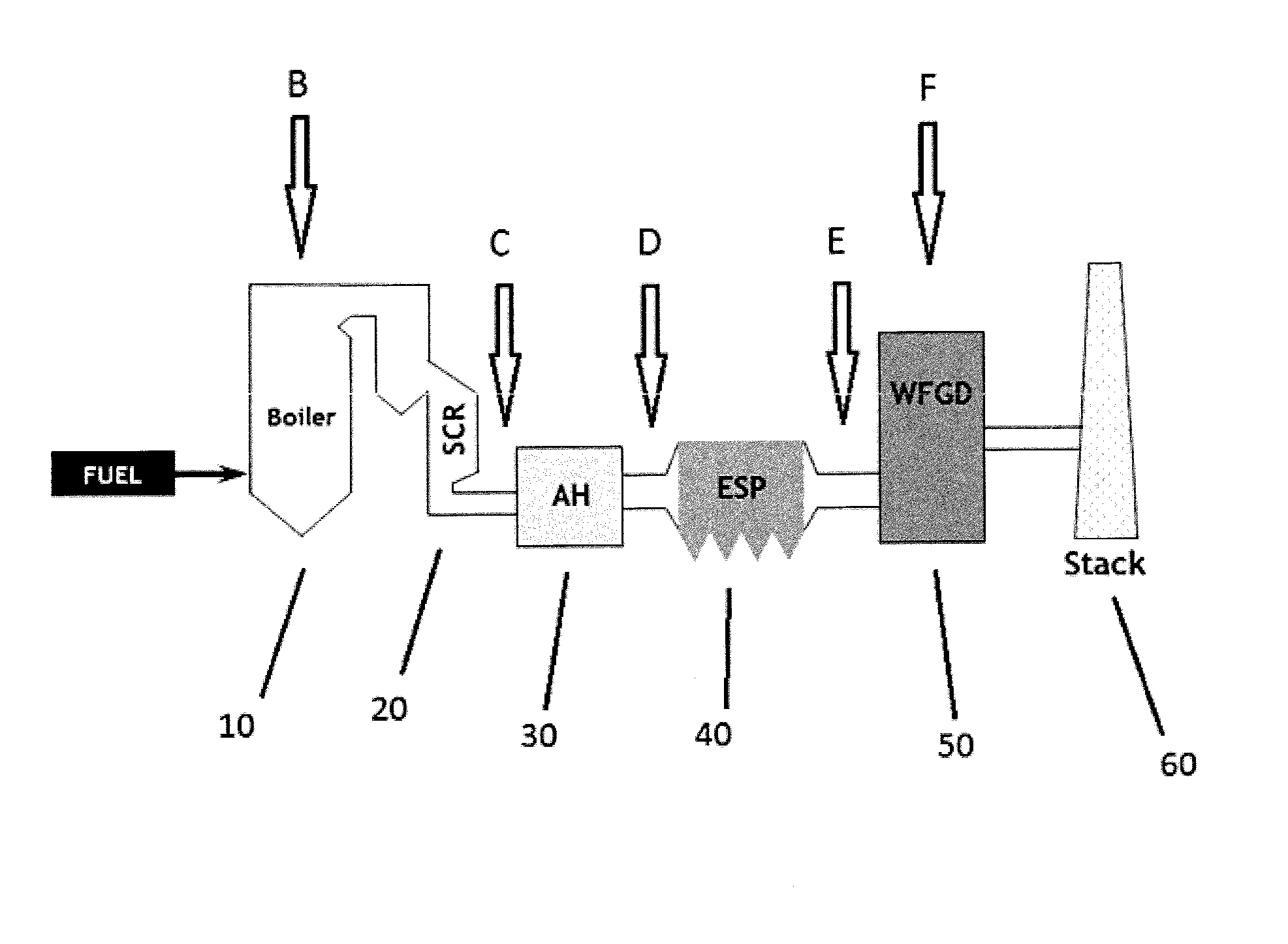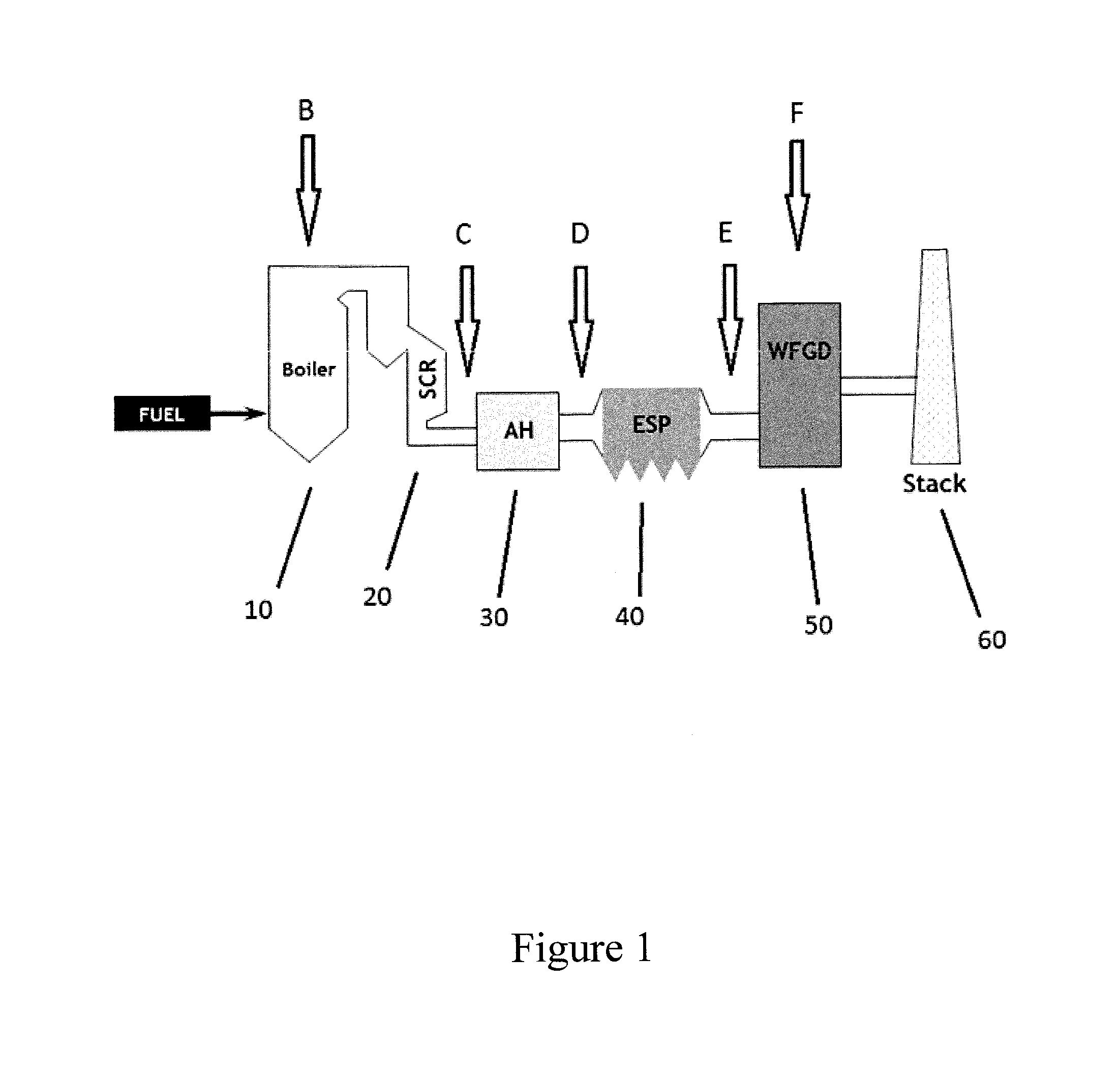Method of oxidizing mercury in flue gas
a flue gas and mercury technology, applied in the direction of emission prevention, separation processes, lighting and heating apparatus, etc., can solve the problems of hydrobromic acid (hbr), the question of whether the use of bromine additives will accelerate the high-temperature corrosion mechanism remains open
- Summary
- Abstract
- Description
- Claims
- Application Information
AI Technical Summary
Benefits of technology
Problems solved by technology
Method used
Image
Examples
example 1
Formation of Gaseous Oxidized Mercury from Mercuric Sulfide
[0066]The instability of mercury sulfide was demonstrated by twice dropping pure mercury sulfide powder into the flue gas duct ahead of an electrostatic precipitator (ESP) where it would be captured and exposed to hot flue gas.
[0067]As shown in FIGS. 2 and 3, each time outlet mercury levels rose sharply above inlet levels after dosing with pure mercury sulfide powder. There was no concomitant increase in elemental mercury levels seen during these experiments, indicating the gaseous form of mercury that had evolved was evidently in an oxidized form. Among the known possible mercury (II) compounds that could conceivably be formed, mercuric chloride (HgCl2) and mercuric bromide (HgBr2) would be sufficiently stable and volatile to be measured by the mercury monitors. Without being bound by theory, it is believed that since coals almost invariably contain far more chlorine relative to bromine, the end product is almost certainly ...
example 2
Injection of Sulfide Source Pre-APH
[0068]As shown in FIG. 4, copper sulfide was injected ahead of an pre air-preheater and resulted in an increase in the percentage of mercury that was oxidized (measured at the stack) from 48% to 85%. These results indicate that introduction of a sulfide source into the flue gas is an effective amount to convert elemental mercury to oxidized mercury, thereby facilitating removal of mercury from the flue gas through systems already in place (e.g., wFGDs). In FIG. 4, TX15047 refers to dry MerControl 6012. The basic formulation from CHARMS is about 68% colloidal silica; about 9.67% sulfur; about 7.21% copper compound; and about 15.13% water.
example 3
Formation of Oxidized Mercury from Polysulfide Species
[0069]It was demonstrated in a bench top experiment, employing an Ohio Lumex spectrometer, that a polysulfide species is capable of oxidizing elemental mercury. An extra impinger was incorporated into the set-up involving the RP-915+ spectrometer to allow the gas to bubble through an extra solution. The use of SnCl2 results in the ionic mercury present in the 500 ppt standard solution to be reduced to elemental mercury and released into the vapor phase travelling through the impinger train. In the 500 ppt Hg baseline experiment, the extra impinger contained 25.2 g DI water, i.e. no extra oxidation or capture is possible. To measure the ability of polysulfide to oxidize mercury, 3.25 g of a 28% solution of calcium polysulfide was added to the extra impinger and the 500 ppt Hg standard was re-run. All experiments were run in triplicate. As shown in Table 1, a 20% reduction in mercury reaching the detector was observed with the poly...
PUM
| Property | Measurement | Unit |
|---|---|---|
| Temperature | aaaaa | aaaaa |
| Temperature | aaaaa | aaaaa |
Abstract
Description
Claims
Application Information
 Login to View More
Login to View More - R&D
- Intellectual Property
- Life Sciences
- Materials
- Tech Scout
- Unparalleled Data Quality
- Higher Quality Content
- 60% Fewer Hallucinations
Browse by: Latest US Patents, China's latest patents, Technical Efficacy Thesaurus, Application Domain, Technology Topic, Popular Technical Reports.
© 2025 PatSnap. All rights reserved.Legal|Privacy policy|Modern Slavery Act Transparency Statement|Sitemap|About US| Contact US: help@patsnap.com



